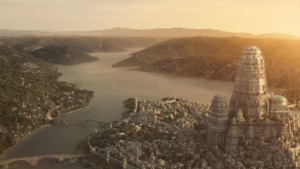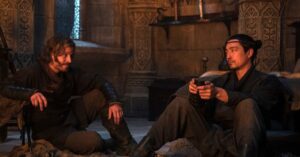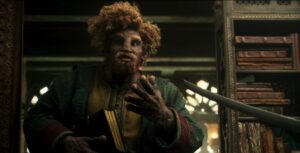SPOILERS FOR THE WHEEL OF TIME EPISODE FIVE AHEAD!
If there’s one criticism that should not be leveled against any streaming series developed by Amazon, one of the biggest and most valuable companies on the planet, it’s that it’s low-budget. And to be fair, Amazon’s The Wheel Of Time isn’t actually low-budget, not by any stretch of the imagination. $80 million dollars, even spread across eight episodes, is a sizable amount of money, roughly on par with what Netflix allocated to The Witcher‘s first season. But The Wheel Of Time uses at least as much CGI as The Witcher, if not more, and that puts a strain on the budget.

And inevitably, sometimes that does result in The Wheel Of Time looking cheaper than it has any right to. I’ve been disappointed in the show’s lackluster production design, poor costuming choices, and occasionally wonky CGI. But while I absolutely hope that Amazon has increased the show’s budget after seeing the strong reception to season one, the silver lining in this situation is that watching the first season, you can admire how the creative team behind The Wheel Of Time have clearly had to think outside the box and find clever solutions to challenges and problems at which they can’t just throw millions of dollars to make them go away.
And that’s how we find ourselves standing before the gates of Tar Valon early in episode five. If you were hoping to read Robert Jordan’s Wheel Of Time books concurrently with the show’s adaptation of each book, this is probably the point where you’re gonna have to choose one or the other, because this is a far more significant deviation from the source material than the show’s decision to cut out the pit-stop in Baerlon on the road to Shadar Logoth or the river-boat journey to Whitebridge. It’s also a bold choice made for practical reasons that not only works in theory, but in execution works better than the books’ equivalent.
In the first book of The Wheel Of Time, the characters aren’t reunited in Tar Valon, but in the city of Caemlyn. They don’t even reach Tar Valon until book two. But in Amazon’s version of events, it’s the other way around; the characters’ paths converge in Tar Valon, and presumably it won’t be until season two or later that we get a chance to visit Caemlyn. The only real downside is that we lose Caemlyn as a location in season one, but that’s not a terribly hard loss to endure. In the first book, it’s only significant as the home of Elayne Trakand, her mother Morgase, and her brothers Gawyn and Galad.
And down the line, when Amazon’s adaptation has room to introduce those characters, that’s when we can expect the show to stop by Caemlyn. But The Wheel Of Time is still in its first season, and still trying to acquaint new fans with as few characters and locations as they absolutely need to understand the story right now. With so much of the story woven around the Aes Sedai sorceress Moiraine Damodred (Rosamund Pike), whose role has even been upgraded in the show from a major supporting character to the lead, it makes total sense to visit her home-city, Tar Valon – the center of Aes Sedai power, and the axis upon which Jordan’s fantasy world rotates.
Swapping out Caemlyn for Tar Valon also allows Amazon’s adaptation to begin weaving a through-line of Aes Sedai political intrigue into this first season, a through-line that fans will follow until the very end of the show. Political intrigue is a major element of Robert Jordan’s Wheel Of Time saga (and, incidentally, one of my favorite tropes in genre fiction), but that’s something that only becomes clear around book two. By contrast, the first book in the series is a fairly straightforward quest narrative styled after The Lord Of The Rings, with little to no politics.
As Amazon’s Wheel Of Time has wisely accentuated the differences between the two series’ (and even discarded some of Jordan’s most…shall we say, overt homages to Tolkien), playing up the intricate machinations of the Aes Sedai in Tar Valon is a far more efficient use of screentime than spending a full episode in Caemlyn, Jordan’s generic fantasy city stand-in for Tolkien’s Minas Tirith. Even outside of the White Tower in which the Aes Sedai live, Tar Valon feels distinct, with a bright and colorful visual aesthetic blending cultural influences from Byzantine Constantinople, Renaissance-era Rome, and medieval Avignon; all cities presided over by religious authorities.
The Aes Sedai are the closest equivalent to the Catholic Church that exists in Robert Jordan’s world – and that’s even taking into account all the intentional similarities between the Whitecloaks and the fanaticism of the Spanish Inquisition. Although their political power doesn’t extend far beyond the shores of their island city, within its walls the Aes Sedai are still revered and respected by the common people. They wield an intangible influence that can alternately be used as a shield or a sword, crafted through centuries of tradition, ritualism, and subtle manipulation of faith, fear, and superstition.
The result is a culture of adoration that exists to keep the people of Tar Valon in check and demonstrates the efficiency of Aes Sedai methods. But the city itself is largely insignificant. Sure, the Aes Sedai entertain their people every so often by parading a gentled False Dragon through the streets and allowing him to face the wraths of their followers, but everything of importance happens inside the echoing hallways and sparsely-decorated chambers of the White Tower, where women from all seven Ajahs work on expanding their influence across the entire world. Tar Valon is only a testing ground.
Sadly, there’s not enough time for Amazon’s series to explore all the nooks and crannies of this rich environment, as the story requires that most of the main characters be escorted into the White Tower at once. Moiraine, we learn, has been away from the Tower for two years, and the Aes Sedai won’t let her leave again without an explanation for her long absence, while Nynaeve al’Meara (Zoë Robins) is of pertinent interest to everybody after her incredible power display in the previous episode. Simultaneously, we see Lan Mandragoran (Daniel Henney) open up in an effort to comfort his fellow Warder Stepin (Peter Fránzen), still reeling from the loss of his Aes Sedai.
The latter subplot is probably the least integral to the overarching storyline of season one, yet in the brief time that we’re given to know Stepin (before he chooses to die by his own hand, finding peace in the belief that he and his beloved Kerene will be reunited in another life), his struggle with the isolating anguish of grief is beautifully intertwined with The Wheel Of Time‘s philosophies on love, death, and life. Perhaps more than any other fantasy series currently running, The Wheel Of Time is first and foremost concerned with regular people, whose stories of everyday pain and joy fill the series of small, intimate vignettes that run throughout this season.
And in a story as vast and epic in scope as this one, it’s truly a testament to The Wheel Of Time‘s masterful writing and direction that it’s able to ensure that the focus remains right where it needs to be, on the characters of the Emond’s Field Five, Moiraine, and Lan. As the story begins following the latter two more closely in episodes five and six, both are understandably humanized – partially due to our expanded access to their private conversations, and partially because they are written to be less stoic and guarded than they were depicted in Jordan’s early books.
I find it interesting that this has proven to be one of the adaptation’s most controversial changes to the source material, because it makes complete sense to me that Moiraine and Lan (and all Aes Sedai/Warder groupings, for that matter) would feel everything more strongly than other people as a result of their empathetic bond. They’re each a sounding-board for the other’s emotions; every flutter of love, every crashing wave of sorrow, every sudden joy. We see this demonstrated during Stepin’s funeral, when Lan is asked to ritually act out the grief of his fellow Warders, but it’s through Moiraine’s tears and the tremble in her hands that we actually feel the weight of his loss.

I certainly don’t feel that Lan is out of character in that scene as some have argued, and I don’t even want to address the bizarre claim being espoused in all the darkest corners of social media that Amazon’s version of Lan has been “emasculated” (that word alone…blech). The irony isn’t lost on me that the men jeering at Lan for being sad at his best friend’s funeral are the same men who will nonetheless describe themselves as “advocates” for mainstream depictions of platonic affection between men in response to literally any representation of queer men onscreen.
Personally, I have a feeling that the bigots in this fandom are still too blinded by their rage over the mere suggestion that Rand al’Thor (Josha Stradowski) could be queer to notice that the only openly queer men in The Wheel Of Time so far are the fairly minor characters of Maksim (Taylor Napier) and Ihvon (Emmanuel Imani), who are part of an adorable polyamorous throuple with their Aes Sedai, Alanna Mosvani (Priyanka Bose). Apparently they also overlooked the fact that Lan and Stepin’s relationship, the crux of episode five, is totally platonic.
We’ve seen varied and highly individual expressions of romantic and sexual love throughout The Wheel Of Time (and even so, only a sampling), but platonic love is a kaleidoscope of vibrant colors too. The tranquility that Moiraine and Lan feel around each other, that allows them to ease into a form of platonic intimacy built on trust and understanding, is distinct from romantic attraction – but at the same time, it’s nothing like the at-times prickly platonic love that Moiraine and Alanna share, or the mutual platonic affection that Lan and Stepin can’t quite bring themselves to voice.
All the Emond’s Field Five are knit tightly together by a kind of platonic love-pentagram, but after this episode it’s clear that we’re supposed to see especially strong bonds of trust and familiarity emerging between Rand and Mat Cauthon (Barney Harris) and between Egwene al’Vere (Madeleine Madden) and Perrin Aybara (Marcus Rutherford). To be honest, I still don’t see it with Rand and Mat. Stradowski and Harris are the weakest links in the ensemble cast, but this episode gives them nothing to work with, not even a proper conversation to communicate the self-loathing and horror that Mat is struggling with, or Rand’s confusion and desperation to help.
But while those two reach Tar Valon in the first few minutes and proceed to wander around aimlessly, Egwene and Perrin take an unexpected detour before they can enter the city and come out the other side with a clearer understanding of themselves and of each other, at a place in their relationship where one can easily imagine them developing their own form of the bond that Moiraine and Lan share. Abducted from the Tuatha’an caravan by fanatical Whitecloaks lurking outside the city gates, Egwene is brought before the Questioner Eamon Valda (Abdul Salis), who tortures Perrin to try and force Egwene into confessing to being a channeler.
The horrific ordeal forces Egwene and Perrin to lay bare all their fears and insecurities in front of each other if they’re to survive, something neither had been able to do up until this point. Shedding the self-doubt that had plagued her, Egwene finally reveals her ability to channel, while Perrin brokenly admits to accidentally killing his wife during the battle of Emond’s Field (in-universe, and specifically as far as Whitecloaks are concerned, the two are comparable crimes). Perrin doesn’t quite have time to explain what the whole glowing golden eyes thing is about, or why he’s being followed around by wolves now, but that’s a story for another day.
Funny story, my notes for this review contain a lengthy critique of The Wheel Of Time‘s CGI-enhanced wolves that will never see the light of day, as I have recently discovered that the wolves are…well, real. I mean, they’re not really wolves, they’re actually wolfdogs, but nor are they CGI, not even a little bit, which means that the problem I had with the level of distance between the human actors and the wolves is apparently not attributable to VFX artists digitally inserting wolves in post-production. I don’t even know why I’m surprised. Honestly, it would be more shocking if The Wheel Of Time had money to afford hyper-realistic CGI wolves.
So basically I still feel it detracts from Perrin’s character arc that the wolves don’t seem to fully inhabit the same space as him and the other actors, but I’m no longer sure what to chalk this up to and I’m sure as hell not gonna blame the wolfdog actors who are all doing a lovely job. Maybe these are just the realities of working with animals on any film or TV set, and I admire the show for once again choosing the practical solution to the challenge of adapting Jordan faithfully, as they’ve done with the beastly Trollocs, the terrifying Myrddraal, and in episode five, the scholarly Ogier Loial (Hammed Animashaun).
Loial trended on Twitter the night of his debut, and for good reason. The Ogier is a fan-favorite, whose meandering dialogue and bemused reactions to humans make him a quaint outlier in a story growing increasingly darker all around him. Acting through several layers of facial prosthetics and reciting what could have been extremely stilted dialogue, Animashaun brings Loial’s endearing awkwardness to life while maintaining his own dignity and successfully conveying that the Ogier has a more solemn side we may get to explore in later seasons – by which point, hopefully, Amazon will have dialed back his prosthetics a bit.
Something that I remember realizing when I first read The Wheel Of Time, only to later forget and realize all over again when watching the show is that Loial is also very clearly inspired by Treebeard. I’m not complaining…I really like Treebeard, and I really like Loial, but it is interesting that his characterization from the books is kept intact in the adaptation process and ironically it leads to a momentarily jarring tonal shift. The rest of the episode is spent untangling an intricate political intrigue narrative while dealing with all these weighty themes, using Jordan’s later books to inform the tone and style, and then here comes Loial.

Personally, I think showrunner Rafe Judkins and his team have proved they’re more than capable of handling the challenges thrown their way, even by their own source material. But at the same time, I’m kind of okay with keeping Loial exactly the way he is. Is he a remnant of the sometimes unsubtle homages to Tolkien that filled the pages of Jordan’s first book? A little bit, yeah, but The Wheel Of Time is otherwise so comfortably situated in its own skin by this point that I think the show can get away with it.
Episode Rating: 9/10